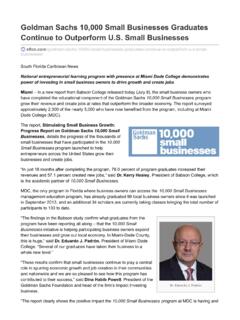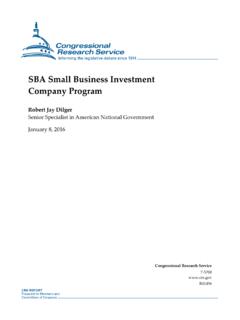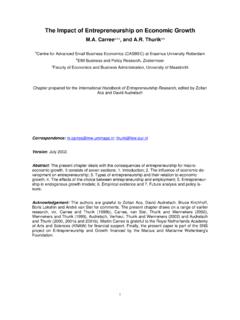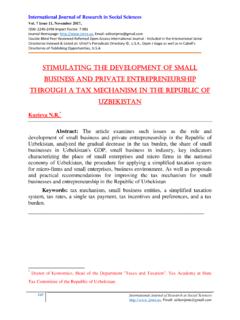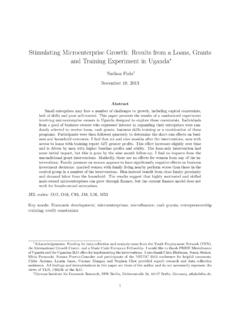Transcription of SBA Small Business Investment Company Program
1 SBA Small Business Investment Company Program Updated February 19, 2021 Congressional Research Service R41456 SBA Small Business Investment Company Program Congressional Research Service Summary The Small Business Administration s (SBA s) Small Business Investment Company (SBIC) Program is designed to enhance Small Business access to venture capital by stimulating and supplementing the flow of private equity capital and long-term loan funds which Small - Business concerns need for the sound financing of their Business operations and for their growth , expansion, and modernization, and which are not available in adequate supply. Facilitating the flow of capital to Small businesses to stimulate the national economy was, and remains, the SBIC Program s primary objective. As of September 30, 2020, there were 302 privately owned and managed SBA-licensed SBICs providing Small businesses private capital the SBIC has raised (called regulatory capital) and funds the SBIC borrows at favorable rates (called leverage) because the SBA guarantees the debenture (loan obligation).
2 SBICs pursue investments in a broad range of industries, geographic areas, and stages of Investment . Some SBICs specialize in a particular field or industry, and others invest more generally. Most SBICs concentrate on a particular stage of Investment ( , startup, expansion, or turnaround) and geographic area. The SBIC Program currently has invested or committed about $32 billion in Small businesses, with the SBA s share of capital at risk about $ billion. In FY2020, SBICs were provided nearly $ billion in SBA leverage and invested another $ billion from private capital for a total of $ billion in financing for 1,063 Small businesses. In recent years, some Members of Congress have argued that the Program should be expanded as a means to stimulate economic activity and create jobs. For example, 113-76, the Consolidated Appropriations Act, 2014, increased the annual amount of leverage the SBA is authorized to provide to SBICs to $4 billion from $3 billion.
3 114-113, the Consolidated Appropriations Act, 2016, increased the amount of outstanding leverage allowed for two or more SBIC licenses under common control (the multiple licenses/family of funds limit) to $350 million from $225 million. 115-187, the Small Business Investment Opportunity Act of 2017, increased the amount of outstanding leverage allowed for individual SBICs to $175 million from $150 million. Others worry that an expanded SBIC Program could result in losses and increase the federal deficit. In their view, the best means to assist Small Business , promote economic growth , and create jobs is to reduce Business taxes and exercise federal fiscal restraint. Some Members have also proposed that the Program target additional assistance to startup and early stage Small businesses, which are generally viewed as relatively risky investments but also as having a relatively high potential for job creation.
4 During the Obama Administration, the SBA established a five-year, early stage SBIC initiative. Early stage SBICs are required to invest at least 50% of their investments in early stage Small businesses, defined as Small businesses that have never achieved positive cash flow from operations in any fiscal year. The SBA stopped accepting new applicants for the early stage SBIC initiative in 2017. This report describes the SBIC Program s structure and operations, focusing on SBIC eligibility requirements, Investment activity, and Program statistics. It also includes information concerning the SBIC Program s debenture SBIC Program , participating securities SBIC Program , impact Investment SBIC Program (targeting underserved markets and communities facing barriers to access to credit and capital), and early stage SBIC initiative.
5 SBA Small Business Investment Company Program Congressional Research Service Contents SBIC Program Overview .. 1 SBIC Types .. 3 SBIC Eligibility Requirements .. 4 SBIC Application Process .. 5 SBIC Capital Investment Requirements .. 6 Debenture SBICs .. 6 Participating Securities SBICs .. 7 Impact Investment SBICs .. 8 Early Stage SBICs .. 9 Key Features of Regular SBIC Types .. 11 SBIC Investments in Small Businesses .. 13 Leverage .. 15 Leverage Drawdown .. 15 Debenture SBIC Leverage Requirements .. 16 Participating Securities SBIC Leverage Requirements .. 17 Impact Investment SBIC Leverage Requirements .. 18 Early Stage SBIC Leverage Requirements .. 19 Reporting Requirements .. 20 SBIC Program Statistics .. 20 Total Financing .. 21 Financing to Underserved Small Businesses .. 23 Financing by State .. 25 Legislative Activity.
6 27 Legislation to Target Additional Assistance to Startup and Early Stage Small Businesses .. 28 Discussion .. 29 Legislation to Increase SBIC Financing Levels .. 30 Discussion .. 32 Concluding Observations .. 32 Tables Table 1. Key Features of the SBA s Debenture, Participating Securities, and Impact Investment Debenture programs and Early Stage Debenture Initiative .. 11 Table 2. Number of Licensed SBICs by Type, FY2010-FY2020 .. 21 Table 3. SBIC Investments, 22 Table 4. Number of Underserved Small Businesses Financed by SBICs, FY2012-FY2020 .. 25 Table 5. SBIC Financing by State, FY2019 .. 25 Appendixes Appendix. Small Business Eligibility Requirements and Application Process .. 35 SBA Small Business Investment Company Program Congressional Research Service Contacts Author Information .. 38 SBA Small Business Investment Company Program Congressional Research Service 1 SBIC Program Overview The Small Business Administration (SBA) administers several programs to support Small businesses, including loan guaranty programs to enhance Small Business access to capital; programs to increase Small Business opportunities in federal contracting; direct loans for businesses, homeowners, and renters to assist their recovery from natural disasters; and access to entrepreneurial education to assist with Business formation and It also administers the Small Business Investment Company (SBIC) Program .
7 Authorized by 85-699, the Small Business Investment Act of 1958, as amended, the SBIC Program is designed to improve and stimulate the national economy in general and the Small - Business segment thereof in particular by stimulating and supplementing the flow of private equity capital and long-term loan funds which Small - Business concerns need for the sound financing of their Business operations and for their growth , expansion, and modernization, and which are not available in adequate supply. 2 The SBIC Program was created to address concerns raised in a Federal Reserve Board report to Congress that identified a gap in the capital markets for long-term funding for growth -oriented Small businesses. The report noted that the SBA s loan programs were limited to providing short-term and intermediate-term credit when such loans are unavailable from private institutions and that the SBA did not provide equity financing.
8 3 Equity financing (or equity capital) is money raised by a Company in exchange for a share of ownership in the Business . Ownership is represented by owning shares of stock outright or having the right to convert other financial instruments into stock. Equity financing allows a Business to obtain funds without incurring debt, or without having to repay a specific amount of money at a particular time. The Federal Reserve Board s report concluded there was a need for a federal government Program to stimulate the availability of capital funds to Small Business to assist these businesses in gaining access to long-term financing and equity Facilitating the flow of capital to Small businesses to stimulate the national economy was, and remains, the SBIC Program s primary objective. The SBA does not make direct investments in Small businesses.
9 It partners with privately owned and managed SBICs licensed by the SBA to provide financing to Small businesses with private capital the SBIC has raised (called regulatory capital) and with funds (called leverage) the SBIC borrows at favorable rates because the SBA guarantees the debenture (loan obligation).5 As of 1 Small Business Administration (SBA), Fiscal Year 2020 Congressional Budget Justification and FY2018 Annual Performance Report, pp. 2-3, at congressional-budget-justification-annua l-performance-report. 2 15 661. 3 Congress, House Committee on Banking and Currency, Small Business Investment Act of 1958, report to accompany , 85th Cong., 2nd sess., June 30, 1958, 85-2060 (Washington: GPO, 1958), pp. 4, 5. Also, see Congress, Committees on Banking and Currency and Select Committees on Small Business , Financing Small Business , report to the Committees on Banking and Currency and Select Committees on Small Business , United States Congress, by the Federal Reserve System, 85th Cong.
10 , 2nd sess., April 11, 1958, Committee Print (Washington: GPO, 1958). 4 Congress, House Committee on Banking and Currency, Small Business Investment Act of 1958, report to accompany , 85th Cong., 2nd sess., June 30, 1958, 85-2060 (Washington: GPO, 1958), p. 5. 5 Small Business Investment companies (SBICs) must invest in Small businesses, defined as those with no more than 49% of employees overseas, less than $ million in tangible net worth and average after-tax income for the preceding two years of less than $ million, or businesses qualifying as Small under the SBA s NAICS industry code size standards. In addition, SBICs are required to invest set percentages of their financings, which vary based on when SBA Small Business Investment Company Program Congressional Research Service 2 September 30, 2020, there were 302 licensed SBICs participating in the SBIC In FY2020, SBICs drew nearly $ billion in In recent years, some Members of Congress have argued that the Program should be expanded as a means to stimulate economic activity and create jobs.










